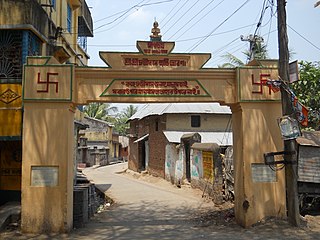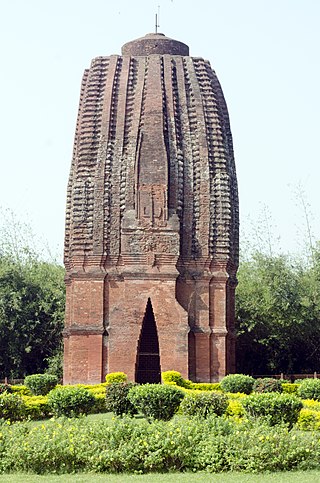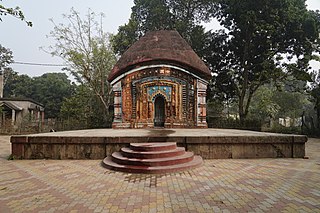
Chandrakona is a town and a municipality in the Ghatal subdivision of Paschim Medinipur district in the state of West Bengal, India. The city is located between Ghatal and Garhbeta. Chandraketu was the founder of the kingdom of Chandrakona. In the Ain-E-Akbari, the 16th century Mughal document, it was mentioned as ‘Mana’.

Khirpai, also known as Kshirpai, is a city and a municipality in the Ghatal subdivision of the Paschim Medinipur district in the state of West Bengal, India. The city is situated between Ghatal and Chandrakona, near the banks of the rivers Shilabati and Kethai, and is one of the oldest municipalities in India. Khirpai is also famous for its Babarsa, a special type of sweetmeat, which is not available elsewhere.

Kharar is a historical town of Ghatal and one of the oldest town in Asia. This city is located in the Ghatal Subdivision of the Indian state of West Bengal. Earlier this town was part of Hooghly District later it was merged with Medinipur district.

Nanoor, is a village in Nanoor CD block in Bolpur subdivision of Birbhum district in West Bengal. Nanoor is the birthplace of 14th century lyric poet Chandidas of Vaishnava Padavali fame. It is developing as a craft centre with NGO support. With the massacres in 2000, Nanoor was in intense media focus.

Bahulara Ancient Temple is located in Bahulara village in the Onda II village panchayat, in the Onda CD block in the Bankura Sadar subdivision of the Bankura district in the Indian state of West Bengal. It is 5 km (3.1 mi) from Ondagram railway station and 25 km (16 mi) from Bishnupur.
Masagram is a village in Ajhapur gram panchayat of Jamalpur CD block in Bardhaman Sadar South subdivision of Purba Bardhaman district in the Indian state of West Bengal.
Daspur is a village, with a police station, in Daspur I CD Block in Ghatal subdivision of Paschim Medinipur district in the state of West Bengal, India. Previously a part of Hooghly District, later in 1872 it was merged with Medinipur district.
Patrasayer is a village in the Patrasayer CD block in the Bishnupur subdivision of the Bankura district in the state of West Bengal, India.

Narajole is a village and gram panchayat in Daspur I CD Block in Ghatal subdivision of Paschim Medinipur district in the state of West Bengal, India.

Sat Deul is a 10th-11th century temple at Deule / Sat Deule in the Memari I CD block in the Bardhaman Sadar South subdivision of the Purba Bardhaman district in the Indian state of West Bengal.
Balsi Purbapara is a village in the Patrasayer CD block in the Bishnupur subdivision of the Bankura district in the state of West Bengal, India.
Paikbheri is a village in the Bhagabanpur I CD block in the Egra subdivision of the Purba Medinipur district in the state of West Bengal, India.
Pathra is a village and a gram panchayat in the Midnapore Sadar CD block in the Medinipur Sadar subdivision of the Paschim Medinipur district in the state of West Bengal, India.
Panchrol is a village and a gram panchayat in the Egra I CD block in the Egra subdivision of the Purba Medinipur district in the state of West Bengal, India.

Chandrakona Jorbangla Temple is a 17th-century stone built temple at Dakshinbazar, Chandrakona in Ghatal subdivision of Paschim Medinipur district in West Bengal, India.
Shantinatha Shiva Temple is a nava-ratna temple, built in 1828 at Mitrasenpur, Chandrakona in Ghatal subdivision of Paschim Medinipur district in West Bengal, India.
Malleswara Shiva Temple is a pancha-ratna temple, built in the 18th century at Chandrakona in Ghatal subdivision of Paschim Medinipur district in West Bengal, India.

Radh Bengal is a region in West Bengal also known as the Temple Town. This region consists of arrays of temples in varying sizes and devoted to different gods and goddess but the common thread unifying this group is that the temples are constructed in terracotta. The region consists of following districts Birbhum, Bankura, Burdwan, Purulia and parts of Murshidabad. The construction style originated in 16th century and lasted till the 19th century. This period is also referred as a golden age of temple in West Bengal. Reason for development of this construction technique was the rich red laterite soil of the region and lack of construction worthy stone. The skill of creating daily objects from like vessels, pottery, seal and toys evolved into a construction technique in the time of need. These temples are baked terracotta panels or bricks. This particular style spread outside the present day West Bengal as well, to Jharkhand, Bihar, Assam and Tripura.

Ratna Style is a style of Bengal temple architecture, that originated in Bengal from the 15th to 16th centuries, under the Mallabhum kingdom. Originating as a regional style in Hindu temple architecture. It is an extended style of the Chala temple. The special feature of Ratna-style temples is the curved cornice of the chala.

Chala Style is a style of Bengal temple architecture, that originated in Bengal from the 15th centuries. Originating as a regional style in Hindu temple architecture. The main features of this style are curved tops and cornices. Chala-style temples in West Bengal were made of mud walls and thatched roofs. But, in East Bengal it was built with bamboo structures and thatched roofs.



















































